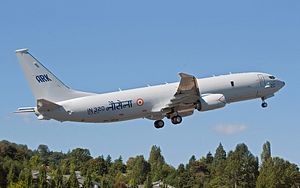The Indian Navy is expected to begin inducting a second batch of Boeing P-8I Neptune advanced maritime patrol/anti-submarine warfare (ASW) aircraft this April, according to Indian defense officials.
In 2016, the Indian Ministry of Defense (MoD) placed a $1.1. billion follow-on order for four additional P-8Is with deliveries set to begin in the first quarter of 2020.
“Based on the contract, the first of the four aircraft will be delivered in mid-2020 and the remaining three in 2021” a Boeing Spokesperson was quoted as saying by the Economic Times on February 17.
In early 2009, the Indian government and Boeing concluded a $2.1 billion deal for the purchase of eight P-8I aircraft becoming the first international customer of an export variant of the U.S.-made maritime patrol aircraft.
The Indian Navy’s first P-8I squadron (Indian Naval Air Squadron 312A) was stood up at a naval base in Rajali in November 2015. The Indian Navy operates its entire fleet of eight P-8I maritime patrol aircraft from Rajali.
The P-8I, a variant of the Boeing P-8A Poseidon, is considered to be one of the most advanced maritime patrol aircraft currently in service around the globe, as I explained previously:
The P-8I is equipped with some of the most modern U.S. anti-submarine warfare (ASW) technology including a Telephonics APS-143 OceanEye aft radar system and a cutting-edge magnetic anomaly detector The APS-143 is not present on the original P-8A Poseidon in use by the U.S. Navy.
The aircraft is also armed with U.S. weapons systems including Harpoon Block-II missiles, MK-54 lightweight torpedoes, rockets, and Mark 82 depth charges. The aircraft are all data-linked with Indian submarines in order to have the capability to pass on information about enemy vessels.
The Indian MoD decided against procuring Mark 82 depth charges for ASW operations and instead to rely on the ASW capabilities of the MK-54 torpedoes and Harpoon Block-II missiles.
In June 2017, Boeing was awarded a three-year contract to continue its support of the Indian Navy’s P-8I fleet.
In April 2019, the Indian and U.S. navies conducted their first bilateral anti-submarine warfare exercise since the signing of a Communications, Compatibility and Security Agreement (COMCASA) in September 2018 that enables closer interoperation between U.S. and Indian military platforms including the P-8I and P-8A fleets of the Indian and U.S. navies.
“Prior to the conclusion of the agreement, the United States had to remove advanced communication equipment from all military platforms sold to India such as the P-8I Neptune,” I explained.
COMCASA now allows P-8I and P-8A aircraft to share real-time operational intelligence, including a secure Common Tactical Picture.
Last June, the Indian MoD approved the procurement of 10 more P-8Is.
Notably, the U.S. Navy is moving forward with plans to integrate the Lockheed Martin AGM-158C Long Range Anti-Ship Missile (LRASM) on the P-8A, according to Naval Air Systems Command (NAVAIR).

































